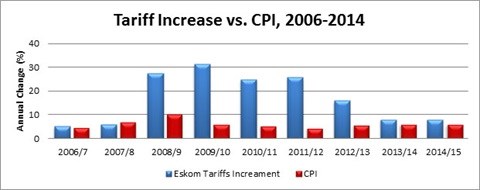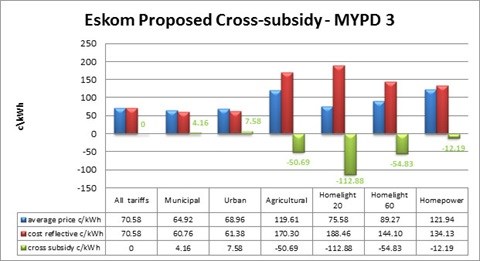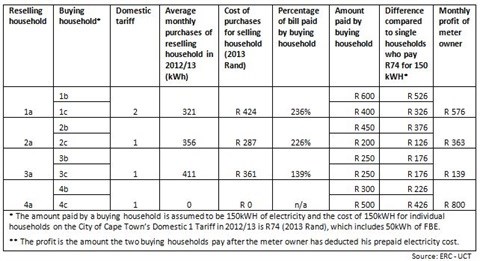The electricity sector in South Africa has been in a state of disruption over the last few years. The country's power utility company, Eskom, has been under scrutiny for several reasons.
Most of these reasons relate to the rolling blackouts, load-shedding episodes of 2007/8 and high levels of inefficiency. Constant tariff increases under the multiyear price determination (MYPD) programme is another major source of discontent towards the utility. The tariff increases have grown from a modest rate of 5.1% in 2006/7 to a peak of 31.3% in 2009/10. As shown in the graph below, these tariff increases were generally at rates above the Consumer Price Index (CPI) and as such, elicited harsh backlash from the general public. Eskom has insisted that these tariff increases are not only justified, but that they are imperative to curb the current power crisis and to prevent the catastrophe experienced in 2007/8-. Even if their claim is true, it begs the question: what impact has the utility's tariff structures and tariff increases had on typical South African households - particularly those falling into the lower portions of the income distribution?
Part of Eskom's justification for price increases has also rested on the claim that historically South Africa has had some of the lowest tariffs in the world. In addition, the utility claims that despite the tariff increases since 2006/7, the country continues to have considerably low tariffs compared to other countries in the world, whether in the developed or developing world. A comparison of average electricity tariffs in 2011 using information obtained from the Organisation for Economic Co-operation and Development (OECD), and past Frost & Sullivan analysis, proves this claim to be true - as illustrated in the graphs below. Frost & Sullivan further identified that South African tariffs are comparatively low, not only in the industrial sector, but in the residential sector as well.
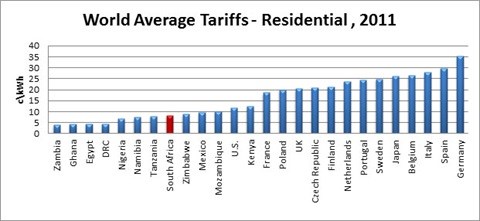
Source: OECD; Frost &Sullivan
click to enlarge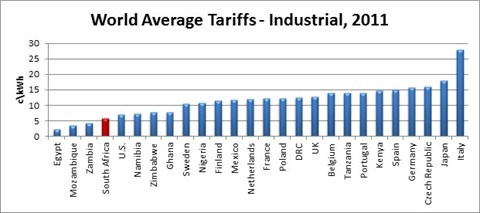
Source: OECD; Frost & Sullivan
click to enlargeIn addition, Frost & Sullivan compared the current residential tariffs in select African countries as of June 2014. Given Eskom's assertion that the average monthly household consumption is 500-750 kWh, this analysis was based on a monthly residential consumption of 500 kWh. The results, shown in the figure below, demonstrate that South African residential tariffs are still low in comparison to other African countries. However, creating a detailed comparison of industrial tariffs is more complex due to the existence of individual tariff agreements between utilities and some energy-intensive users. An example of such an arrangement is the agreement between Eskom and the mining company, BHP Billiton. The details of this agreement have been kept confidential and the agreement is alleged to span over approximately 30 years. A comparison of 2014 industrial tariffs was thus not included in the scope of this research.
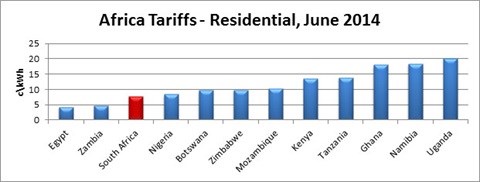
Source: Respective Utilities
click to enlargeThe massive tariff hikes proposed by Eskom are suggested to be an attempt by the utility to catch up with global best practices. Eskom operations need to be financially sustainable in order for the utility to facilitate the introduction of more independent power producers (IPPs) (and ensure the bankability of IPP projects), attract investment to enable capacity expansion, and to carry out its maintenance and repair operations. Many developing countries - particularly in Africa - are moving towards a cost reflective, financially sustainable business model for power generation, transmission and distribution, while most countries in the developed world have already implemented such strategies. Egypt, the country with the lowest tariffs in our African country analysis, has even announced a move to eradicate subsidies and double electricity tariffs over the next five years. Prior to this increase, Egypt's tariffs were less than half the electricity production cost. Namibia also announced a 13% price increase effective 1 July 2014, citing revenue recovery and the burden of intensive capital investment expenditure incurred as their reasons for the tariff increase. Eskom's move to increase tariffs therefore seems to be somewhat in-sync with trends across the continent.
Despite the ostensibly legitimate reasoning behind the Eskom tariff increases, these raised costs will undoubtedly hurt those in the lower portion of South Africa's income distribution. The country's electrification rate of 85.3% (as of 2013) is higher than those of the world, developing world and Sub-Saharan Africa at 80.5%, 74.7% and 30.5% respectively. However, this near-universal electrification rate, coupled with the comparatively low tariffs, does not necessarily imply universal affordability of electricity for all South Africans. Given the incidence of "energy poverty" in low income households in South Africa, the government, in conjunction with Eskom and municipalities, has introduced the following measures to ensure that the tariff increases do not sink poor South Africans further into poverty:
- Electrification Grants - funds allocated by government to assist and speed up electrification
- Free Basic Energy (FBE)- free energy (electricity or alternatives) made available to low income households
- Cross-subsidies - charging a higher tariff to richer households to subsidize households at the bottom of the income distribution
Although it is evident that significant pro-poor initiatives have been introduced, there is still a vast gap between the planning and announcement of these efforts and actual implementation.
Eskom has made phenomenal progress in connecting South African households to the grid; between 1994 and 2014, the utility was able to connect 5.7 million households. However, the utility was unable to achieve the goal of universal electrification by 2014. As of the 2011 census, 3.3 million households were yet to be connected. 75% of these households were in Eskom areas and the remainder under municipality jurisdiction. In addition, the final batch of households requiring connection includes rural households that are remote and more costly to connect. Inadequate funding, thus, proved to be a major barrier Eskom faced in achieving the electrification target on time and meeting government expectations.
Another major hurdle is ensuring integrated planning between all the necessary stakeholders - the Department of Energy (DoE), provincial government, Eskom and local municipalities. As cited by Eskom, this would entail creating policies that facilitate the implementation process and finding a means to consolidate government initiatives, such the electrification and housing programmes. Therefore, despite Eskom's past successes, the path to overcoming energy poverty within South Africa remains a challenging one.
Though the concept of Free Basic Energy was introduced as a means of providing energy for the basic needs of indigent households, implementation has not been without its challenges. The major challenge, as highlighted by the DoE, is the "lack of indigent policies; the registration, verification and management of indigents; contravention of policy; and token collection." In other words, the execution of this concept is complex and has not been carried out effectively. Moreover, Free Basic Electricity assumes that people use not only basic, but energy efficient technologies. However, according to Frost & Sullivan analysis, 75% of South Africa's population (LSM groups 1-5) indicates that, although they are concerned about saving electricity, they cannot afford to spend money on energy efficient technologies. This is exacerbated by the fact that besides energy saving lamps, there is limited availability of low-cost, energy efficient appliances in South Africa. These challenges might intensify given the fact that of the 3.3 million people that are yet to be connected, the majority of those have been identified by the government as poor.
While the process of cross-subsidising tariffs is benevolent in theory, its implementation in South Africa has been a contentious issue and its impact is hard to determine. The figure below indicates how cross-subsidisation works, as proposed by Eskom in its MYPD 3 application. It underscores how Homelight 20 and 60 consumers (the majority of residential consumers fall under these two categories) would pay a tariff considerably less than the cost reflective price. The idea is to protect low- and medium-earning households from the effects of tariff increases, while moving towards a cost-reflective model. An added benefit is that any high consumption and/or energy wasting households are forced to implement energy saving solutions to curb the increase in their electricity bill.
However, challenges arise due to the lack of transparency in the cross-subsidy schemes being employed by municipalities. This has a significant effect as municipalities supply almost half of the energy produced by Eskom, and a significant amount of electricity is consumed by the poor. Moreover, these schemes are difficult for consumers to understand since there are too many different tariff structures - over 2000 - based on the area and municipality. There is subsequently an urgent need for standardisation of tariffs across the board.
Regardless of the above-mentioned challenges facing Eskom's pro-poor initiatives, Frost & Sullivan believes that the utility has made significant progress in an effort to protect lower income households from tariff increases. Measures such as electrification grants, free basic energy and cross-subsidies are a step in the right direction and also align with global best practices. However, the situation at hand leaves Eskom and the South African government in a conundrum. Due to the rising costs in coal, generation costs are on the rise, and with the increase in electricity demand, there is a desperate need for generation capacity expansion. To perform maintenance and repairs of existing infrastructure, transmission and distribution costs will need to increase. Failure to meet these rising costs will put a strain on the utility and consequently; the economy and livelihood of millions of South Africans, especially the poor. Therefore, as reforms are rolled out, the government and the utility need to ensure that individuals that constitute the lower end of the income spectrum are not adversely affected - both in theory and in implementation.
Frost & Sullivan compared its analysis with studies carried out by Lana Franks and Gisela Prasad from the Energy Research Centre (ERC) at the University of Cape Town (UCT). The report titled "The impact of rising electricity tariffs on the urban poor - A South African case study" comprised of several studies on the topic of electricity tariffs and their impact on urban indigent households. In one of the studies, the researchers analysed the effect of informal electricity reselling and its impact on the residents of an informal settlement, Imizamo Yethu, located just outside Cape Town. The results from the research showed that in most cases, several houses in the informal settlement were connected to a single household that had a legal connection to the municipality power line - due to insufficient legal connections were available. The owners of the legally connected household would then resell the electricity at a profit to their neighbours who did not have a legal connection to the municipality line.
The figure above demonstrates that households end up paying a lot more than they would have to, if they had their own connection. As an example, household 1b pays R600, which is R526 more than it would have to, if the household had its own connection. Therefore, in reality, poorer households may not benefit from Eskom's Free Basic Electricity and cross-subsidisation policies as they should, and may instead be incurring electricity bills they truly cannot afford. In some rare occasions, the owner of the legal connection is able to bypass the metre, yet still charges the other households for electricity as usual, even though the electricity is unpaid. This is a possible explanation for the zero purchases from household 4a, and yet the other households still paid for electricity. In this case, not only are the households 4b and 4c being overcharged for electricity, Eskom loses potential revenue from all three households.
During the study, the researchers also analysed the real increase in electricity cost between 2006/07 and 2013/14 for low, medium, and high consumption households.
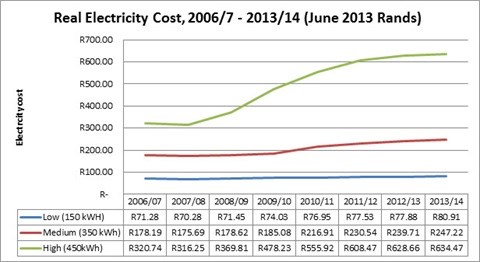
Source: ERC - UCT
click to enlargeThe graph above shows the real cost of electricity between 2006/07 and 2013/14, taking the CPI into account. From this diagram it can be seen that, in theory, low consumption households should only have experienced a slight increase in the real cost of electricity between 2006/07 and 2013/14. However, if higher electricity consumption on a single connection places their tariffs outside the lifeline tariff, the results of the above graphs reveal that low income households would not only fail to benefit from the Free Basic Electricity allocation, but end up incurring significantly higher real electricity costs. The true escalation of average electricity costs will consequently be significantly underestimated if the gaps between such realities and theoretical scenarios are not taken into account.
Frost & Sullivan analysis - substantiated by studies by the ERC at UCT - yields results that are at odds with each other. Despite the commendable effort made by Eskom and several other participants to protect indigent households, these households are still indirectly adversely affected by the tariff increases. Most low income households are located in informal settlements where several households share one legal electricity connection. The high electricity consumption on the one connection places the households in higher tariff blocks, and coupled with the premium charged by the resellers, it results in higher energy bills and the households fail to benefit from the pro-poor initiatives. The main challenge is the arrangement of the informal settlements, and also the lack of awareness of the benefits of the pro-poor initiatives. To resolve the challenges that remain, action is required from several different stakeholders including Eskom and other government departments. Government departments responsible for housing and settlements can play a crucial role in assisting settlers in obtaining permits and title deeds that will enable them to have legal, individual connections to their households. In addition, Eskom will need to ramp up awareness campaigns in the informal settlements to encourage people to switch to individual connections and benefit from initiatives aimed towards low consumption households. In essence, it is up to Eskom and the government to ensure that pro-poor initiatives are implemented effectively and truly produce the desired outcomes.





















































